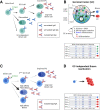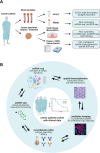Germinal center-dependent and -independent immune responses of tumor-infiltrating B cells in human cancers
- PMID: 37419983
- PMCID: PMC10468534
- DOI: 10.1038/s41423-023-01060-7
Germinal center-dependent and -independent immune responses of tumor-infiltrating B cells in human cancers
Abstract
B cells play essential roles in immunity, mainly through the production of high affinity plasma cells (PCs) and memory B (Bmem) cells. The affinity maturation and differentiation of B cells rely on the integration of B-cell receptor (BCR) intrinsic and extrinsic signals provided by antigen binding and the microenvironment, respectively. In recent years, tumor infiltrating B (TIL-B) cells and PCs (TIL-PCs) have been revealed as important players in antitumor responses in human cancers, but their interplay and dynamics remain largely unknown. In lymphoid organs, B-cell responses involve both germinal center (GC)-dependent and GC-independent pathways for Bmem cell and PC production. Affinity maturation of BCR repertoires occurs in GC reactions with specific spatiotemporal dynamics of signal integration by B cells. In general, the reactivation of high-affinity Bmem cells by antigens triggers GC-independent production of large numbers of PC without BCR rediversification. Understanding B-cell dynamics in immune responses requires the integration of multiple tools and readouts such as single-cell phenotyping and RNA-seq, in situ analyses, BCR repertoire analysis, BCR specificity and affinity assays, and functional tests. Here, we review how those tools have recently been applied to study TIL-B cells and TIL-PC in different types of solid tumors. We assessed the published evidence for different models of TIL-B-cell dynamics involving GC-dependent or GC-independent local responses and the resulting production of antigen-specific PCs. Altogether, we highlight the need for more integrative B-cell immunology studies to rationally investigate TIL-B cells as a leverage for antitumor therapies.
Keywords: antibody; cancer; germinal center; plasma cell; tertiary lymphoid structure.
© 2023. The Author(s).
Conflict of interest statement
EV and RR are employees of Innate Pharma. EP and PM have no relevant conflict of interest to disclose.
Figures




Similar articles
-
Negative selection of human germinal center B cells by prolonged BCR cross-linking.J Exp Med. 1996 May 1;183(5):2075-85. doi: 10.1084/jem.183.5.2075. J Exp Med. 1996. PMID: 8642318 Free PMC article.
-
Tumor-Infiltrating B Lymphocyte Profiling Identifies IgG-Biased, Clonally Expanded Prognostic Phenotypes in Triple-Negative Breast Cancer.Cancer Res. 2021 Aug 15;81(16):4290-4304. doi: 10.1158/0008-5472.CAN-20-3773. Epub 2021 Jun 15. Cancer Res. 2021. PMID: 34224371 Free PMC article.
-
B cell intrinsic and extrinsic factors impacting memory recall responses to SRBC challenge.Front Immunol. 2022 Jul 28;13:873886. doi: 10.3389/fimmu.2022.873886. eCollection 2022. Front Immunol. 2022. PMID: 35967317 Free PMC article.
-
Germinal center responses to complex antigens.Immunol Rev. 2018 Jul;284(1):42-50. doi: 10.1111/imr.12661. Immunol Rev. 2018. PMID: 29944756 Free PMC article. Review.
-
The NFκB signaling system in the generation of B-cell subsets: from germinal center B cells to memory B cells and plasma cells.Front Immunol. 2023 Dec 11;14:1185597. doi: 10.3389/fimmu.2023.1185597. eCollection 2023. Front Immunol. 2023. PMID: 38169968 Free PMC article. Review.
Cited by
-
Exploring effects of gut microbiota on tertiary lymphoid structure formation for tumor immunotherapy.Front Immunol. 2025 Mar 7;15:1518779. doi: 10.3389/fimmu.2024.1518779. eCollection 2024. Front Immunol. 2025. PMID: 40124706 Free PMC article. Review.
-
Dynamic roles of tumor-infiltrating B lymphocytes in cancer immunotherapy.Cancer Immunol Immunother. 2025 Feb 1;74(3):92. doi: 10.1007/s00262-024-03936-7. Cancer Immunol Immunother. 2025. PMID: 39891668 Free PMC article. Review.
-
Single-cell transcriptomics analysis reveals that the tumor-infiltrating B cells determine the indolent fate of papillary thyroid carcinoma.J Exp Clin Cancer Res. 2025 Mar 11;44(1):91. doi: 10.1186/s13046-025-03341-7. J Exp Clin Cancer Res. 2025. PMID: 40069827 Free PMC article.
-
B cell responses and antibody-based therapeutic perspectives in human cancers.Cancer Rep (Hoboken). 2024 Mar;7(3):e2056. doi: 10.1002/cnr2.2056. Cancer Rep (Hoboken). 2024. PMID: 38522010 Free PMC article. Review.
-
Povetacicept (ALPN-303; TACI vTD-Fc), an enhanced, potent dual inhibitor of BAFF and APRIL, ameliorates experimental autoimmune myasthenia gravis in C57BL/6N mice.Front Immunol. 2025 Jun 6;16:1533093. doi: 10.3389/fimmu.2025.1533093. eCollection 2025. Front Immunol. 2025. PMID: 40547042 Free PMC article.
References
-
- Attaf N, Baaklini S, Binet L & Milpied P. Heterogeneity of germinal center B cells: New insights from single-cell studies. Eur J Immunol. 2021. 10.1002/eji.202149235. - PubMed
-
- Apoptosis and antigen affinity limit effector cell differentiation of a single naïve B cell. Science. 2015. https://www.science.org/doi/10.1126/science.aaa1342. - DOI - PMC - PubMed
Publication types
MeSH terms
Substances
LinkOut - more resources
Full Text Sources
Medical
Miscellaneous

